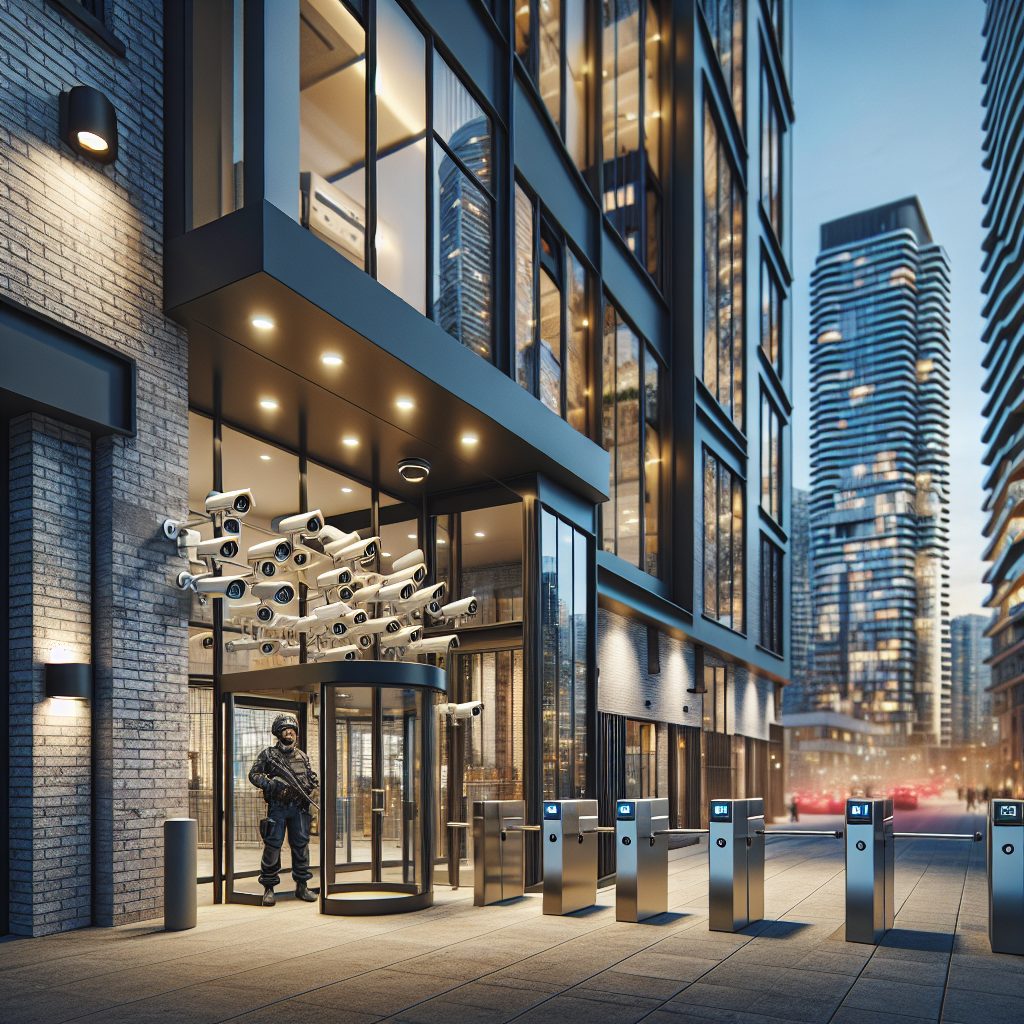Access control systems for buildings in Toronto are an essential part of today’s security infrastructure. These systems provide a way to manage who has access to a building, ensuring that only authorized individuals can enter. It is interesting to note that access control systems are not limited to traditional locks and keys. In fact, they have evolved significantly in recent years, incorporating advanced technologies such as biometrics, card readers, and even facial recognition.
One of the key impacts of access control systems in Toronto is the increased security they provide. With traditional locks and keys, there is always the risk of unauthorized individuals gaining access to a building. However, with access control systems, the process of granting or denying access can be tightly controlled, minimizing the chances of a security breach. This is particularly important for high-security buildings such as government institutions, corporate offices, and healthcare facilities.
Moving forward, let’s delve into the key takeaways of access control systems for buildings in Toronto. We will explore the different types of access control technologies available, their benefits, and how businesses can choose the right system for their specific needs. By understanding these key takeaways, readers will be empowered to make informed decisions when it comes to implementing access control systems in their own buildings.
Key Takeaways
1. Access control systems are crucial for ensuring the safety and security of buildings in Toronto.
2. These systems provide various security measures such as key cards, biometric verification, and remote access control.
3. Integration of access control systems with other building systems like CCTV and alarms enhances overall security and surveillance.
4. Access control systems offer flexibility in managing and monitoring access permissions for different individuals and groups.
5. The adoption of advanced technologies like cloud-based access control and mobile credentials is increasing in Toronto, enabling efficient and convenient access management.
1. Can Access Control Systems for Buildings in Toronto Enhance Security and Efficiency?
2. Understanding the Importance of Access Control Systems
3. Types of Access Control Systems
4. Benefits of Access Control Systems for Buildings in Toronto
5. Key Features to Look for in Access Control Systems
6. Factors to Consider when Choosing Access Control Systems
7. Implementing Access Control Systems in Toronto
8. Maintenance and Upkeep of Access Control Systems
9. Enhancing Security with Access Control Systems
10. Future Trends in Access Control Systems for Buildings in Toronto
2. Understanding the Importance of Access Control Systems
Access control systems are crucial for buildings in Toronto to maintain security and regulate the entry and exit of individuals. These systems act as a protective barrier against unauthorized access and play a vital role in ensuring the safety of occupants and assets within the premises. By implementing access control systems, building owners can effectively monitor and control who enters the building, when they enter, and where they are allowed access.
3. Types of Access Control Systems
There are various types of access control systems available for buildings in Toronto:
– Keycard-based access control systems: These systems utilize keycards with embedded data to grant access to authorized individuals.
– Biometric access control systems: These systems use unique physical or behavioral characteristics, such as fingerprints or retina scans, to authenticate individuals.
– Keypad-based access control systems: These systems require individuals to enter a code or PIN to gain entry.
– Proximity-based access control systems: These systems use proximity devices, such as RFID tags or smartphone apps, to grant access.
4. Benefits of Access Control Systems for Buildings in Toronto
Implementing access control systems in Toronto buildings offers several advantages:
– Enhanced security: Access control systems provide a robust security solution by restricting access to authorized individuals only.
– Increased safety: By preventing unauthorized entry, access control systems help maintain a safe environment within buildings.
– Improved efficiency: These systems streamline access processes, eliminating the need for traditional keys and reducing administrative work.
– Audit trails: Access control systems generate detailed logs of entry and exit activity, enabling better monitoring and investigation of incidents.
– Flexibility: Access permissions can be easily updated or revoked, allowing building owners to adapt to changing needs or personnel.
– Integration capabilities: Access control systems can be integrated with other building management systems, such as video surveillance or alarm systems, for enhanced security and control.
5. Key Features to Look for in Access Control Systems
When choosing access control systems for buildings in Toronto, consider the following key features:
– Scalability: Ensure that the system can accommodate future expansion or changes in the building’s needs.
– User-friendly interface: Look for systems with intuitive interfaces that are easy to navigate and operate.
– Remote access management: Opt for systems that allow remote monitoring and management of access permissions.
– Integration capabilities: Consider systems that can integrate with existing or future security systems for a comprehensive solution.
– Customization options: Look for systems that offer flexibility in configuring access levels, schedules, and permissions.
6. Factors to Consider when Choosing Access Control Systems
When selecting access control systems for Toronto buildings, keep these factors in mind:
– Building size and layout: Consider the physical characteristics of the building and the number of access points for effective system deployment.
– Regulatory compliance: Ensure that the chosen system aligns with local and national regulations regarding access control and security.
– User requirements: Assess the specific needs of the building’s occupants and determine the level of security and access control necessary.
– Budget: Consider the initial investment, ongoing maintenance costs, and potential future upgrades to select a system that fits within the allocated budget.
7. Implementing Access Control Systems in Toronto
Implementing access control systems in Toronto buildings involves several steps:
– Conduct a security assessment: Evaluate the existing security measures and identify areas that require access control systems.
– Develop a plan: Create a comprehensive plan detailing the type of access control system, necessary infrastructure, and budget considerations.
– Installation and configuration: Engage professional security system providers for the proper installation and configuration of the chosen access control system.
– User training: Ensure that building occupants and administrators receive adequate training on how to use and manage the access control system.
– Testing and optimization: Conduct thorough testing to ensure the system functions properly and fine-tune configurations for optimal performance.
8. Maintenance and Upkeep of Access Control Systems
Regular maintenance is essential to ensure the longevity and effectiveness of access control systems in Toronto buildings. Consider the following maintenance practices:
– Scheduled inspections: Regularly inspect all access control components, including readers, controllers, and software, for signs of wear or damage.
– Software updates: Keep the access control system’s software up to date to benefit from new features, bug fixes, and enhanced security.
– Backup and recovery: Implement regular data backups to prevent loss of access control configurations and user data.
– Proactive troubleshooting: Address any issues or malfunctions promptly to avoid prolonged downtime and compromised security.
– Vendor support: Establish a service agreement with the access control system provider for expert assistance and timely support.
9. Enhancing Security with Access Control Systems
Access control systems can be further optimized to enhance security in Toronto buildings:
– Two-factor authentication: Implementing additional layers of authentication, such as combining keycards with biometric verification, adds an extra level of security.
– Visitor management integration: Integrate visitor management systems with access control systems to monitor and regulate guest access effectively.
– Real-time monitoring and alerts: Utilize security management software to receive instant notifications of unauthorized access attempts or suspicious activities.
– Emergency lockdown capabilities: Enable emergency lockdown features to quickly secure the building during critical situations.
– Regular security audits: Conduct periodic security audits to identify vulnerabilities and ensure the access control system remains effective and up to date.
10. What are the essential tips for maintaining and optimizing Access Control Systems for Buildings in Toronto?
- Perform regular maintenance checks to ensure all components are functioning properly.
- Keep the access control system software up to date with the latest patches and upgrades.
- Establish backup procedures to prevent data loss and ensure quick recovery in case of system failure.
- Train employees and administrators on how to use the access control system effectively.
- Regularly review access permissions and update them as needed, especially when personnel changes occur.
- Conduct security audits to identify potential vulnerabilities and address them promptly.
- Stay informed about the latest trends and advancements in access control systems to continuously improve security.
Frequently Asked Questions:
1. What is an access control system?
An access control system is a security system that allows or restricts access to a building or specific areas by authorized personnel only. It typically involves the use of electronic devices such as key cards, biometric scanners, or PIN codes to grant entry.
2. Why should I invest in an access control system for my building in Toronto?
An access control system offers enhanced security and convenience for your building. It eliminates the need for traditional lock systems and provides better control over who enters specific areas. Additionally, it can track and record access attempts, enhancing accountability and helping in investigations if needed.
3. Are access control systems suitable for all types of buildings in Toronto?
Yes, access control systems are flexible and can be customized to suit various types of buildings, such as offices, residential complexes, hospitals, schools, or hotels. Whether you have a small building or a large facility, there are access control options available to meet your specific requirements.
4. How does an access control system work?
An access control system typically consists of electronic devices like card readers, biometric scanners, access control panels, and dedicated software. Authorized individuals are granted access by presenting their credentials, such as a key card or fingerprint, which are authenticated by the system. Once verified, the system triggers the unlocking mechanism, allowing entry.
5. Can an access control system be integrated with other security systems?
Yes, access control systems can be integrated with various other security systems, such as CCTV cameras, intruder alarms, or fire alarm systems. Integration enhances overall security by allowing coordinated responses to potential threats and providing a comprehensive view of the building’s security status.
6. What happens if there is a power outage?
Most access control systems have backup power sources, such as batteries or generators, to ensure continuous operation during power outages. These backup systems ensure that the access control system remains functional, minimizing disruptions to security protocols.
7. How secure are access control systems?
Access control systems employ advanced encryption technology, making unauthorized access extremely difficult. Additionally, the use of biometric authentication adds an extra layer of security by ensuring that only authorized individuals are granted access. Regular system updates and maintenance also help keep the system secure against potential vulnerabilities.
8. Can I grant temporary access to visitors or contractors?
Yes, access control systems often provide options to grant temporary access to visitors or contractors. This can be done by issuing temporary access cards, PIN codes, or utilizing visitor management systems integrated with the access control system. Temporary access can be easily revoked once it is no longer required.
9. What are the maintenance requirements for an access control system?
Typically, access control systems require regular maintenance to ensure optimal performance. This includes software updates, hardware inspections, and occasional repairs or replacements. It is recommended to have a professional service provider to perform routine maintenance tasks for your access control system.
10. How much does an access control system cost?
The cost of an access control system can vary depending on various factors, such as the size of the building, the number of access points, and the desired features. It is best to consult with security system providers in Toronto who can assess your specific requirements and provide a customized quote.
Final Thoughts: Access Control Systems for Buildings in Toronto
Investing in a reliable access control system for your building in Toronto is a prudent decision to enhance security and streamline access management. With the ability to grant or restrict access to authorized individuals and track entry attempts, these systems provide peace of mind and act as a powerful deterrent against potential security breaches.
In a bustling city like Toronto, where various types of buildings coexist, implementing tailored access control systems ensures the safety and protection of occupants, assets, and sensitive information. By integrating access control systems with other security measures, such as surveillance cameras or alarm systems, a comprehensive security infrastructure can be established to mitigate risks effectively.






Recent Comments